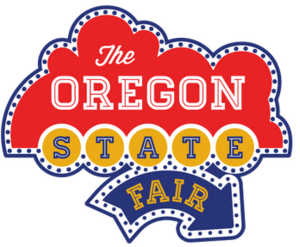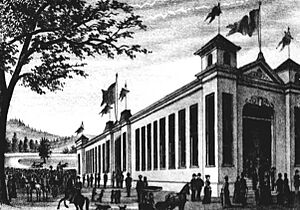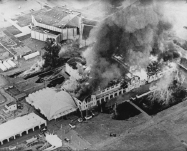Oregon State Fair facts for kids
Quick facts for kids Oregon State Fair |
|
|---|---|
 |
|
| Genre | State fair |
| Dates | August–September including Labor Day |
| Location(s) | Salem, Oregon |
| Years active | 1858–present (excluding 1905, 1942–1944, 2020) |
| Website | www.oregonstatefair.org |
The Oregon State Fair is Oregon's official state fair. It happens every year in late summer, usually from August into September. The fair takes place at the Oregon State Fairgrounds in Salem, which is the capital city of Oregon. The fairgrounds are huge, about 185 acres! The fair has been held there almost every year since 1862. Since 2006, the fair has been managed by the Oregon State Fair & Exposition Center (OSFEC). This group also hosts other events at the fairgrounds all year long.
Discovering the Fair's Past
In the early 1800s, farming grew a lot in Oregon. Farmers started groups to share ideas about growing crops and raising animals. These groups began holding local fairs, like the Yamhill County Fair in 1850. Soon, people wanted a fair for the whole state.
How the Fair Began
A group called the Oregon Fruitgrowers Association held the first unofficial state fair in 1858. This year is now celebrated as the fair's beginning. In 1860, this group joined with others to form the Oregon State Agricultural Society. They held the first official state fair in 1861 near Gladstone and Oregon City.
People soon realized they needed a bigger space. So, in 1862, the second official state fair moved to Salem. It has been held there ever since! A homesteader named John Savage gave 8 acres of his land for the fair. Another pioneer, John Minto, gave money to build a wooden fence around the grounds. The fairgrounds became part of Salem in 1921.
Times the Fair Didn't Happen
The Oregon State Fair has been held almost every year on the same spot. But there were a few times it didn't happen or was very small.
- In 1905, it was skipped because a big event called the Lewis and Clark Centennial Exposition was happening in Portland.
- During World War II, in 1943 and 1944, the fairgrounds were used by the military.
- The 1942 fair was much smaller, only showing 4-H projects and livestock. It wasn't considered a full State Fair.
- In 2020, the fair was canceled because of the COVID-19 pandemic.
The 1967 Fire Incident
In 1967, just before the fair was supposed to open, a fire started on the grounds. Several large buildings burned down. But Governor Tom McCall and the fair organizers decided the fair must go on! Many people and groups helped clean up and donated tents. Even the Portland Rose Festival sent supplies. Because of this teamwork, the fair opened on time.
Historic Buildings at the Fairgrounds
|
Oregon State Fair Stadium and Poultry Building Ensemble
|
|
| Location | 2330 17th Ave NE Salem, Oregon |
|---|---|
| Built | 1919, 1921 |
| Architectural style | Mission/Spanish |
| NRHP reference No. | 02000671 |
| Added to NRHP | June 20, 2002 |
The Oregon State Fairgrounds has two historic buildings. They are listed on the National Register of Historic Places. These are the Oregon State Fair Stadium and the Poultry Building. The horse stadium was built in 1919, and the poultry building in 1921. They were added to the historic register in 2002. The poultry building is famous for its "chicken head" sculptures on the outside. The horse stadium is the oldest state building in Oregon that is still used all the time.
The Special Heritage Oak Grove
In 2007, a group of very old Oregon White Oak trees was recognized as an Oregon Heritage Tree site. These trees are about 200 years old! They are located across the street from the main fairgrounds. Long ago, the Kalapuya people, who lived in the area, used this grove. They would camp there and gather acorns and camas plants. Later, fairgoers also camped in the grove. They would arrive in wagons and set up a "tent city" during the fair. People still camp there today.
Changes in Fair Management
After facing some money problems, the Oregon State Legislature asked the Oregon Parks and Recreation Department to manage the fair. This change happened in 2006. In 2008, the fair's slogan was: "It's like a magical enchanted land. Except real."
Exciting Events at the Fair
Over the years, the Oregon State Fair has shown off many things. These include Oregon's crops and farm animals, local art, and culture. The fair also has many food booths and vendors. You can find judging competitions, horse racing, and popular entertainers. In 2007, the fair even hosted its first Lucha Libre event, which is a type of Hispanic wrestling!
Fairground Facilities
L. B. Day Amphitheatre
Outdoor concerts are held at the L. B. Day Amphitheatre. This venue was named in 1987 after L. B. Day. He was an Oregon State Senator and a big supporter of the fair.
Oregon State Fairgrounds Pavilion
The Oregon State Fairgrounds Pavilion is the newest building on the fairgrounds. It was finished in 2004. This indoor pavilion can hold 5,000 people. It is used all year for many different events. The pavilion and its parking area replaced an old grandstand built in 1929. It also replaced the horse racing track. Some decorations from the old grandstand were saved to be used in the new building. In 2024, a football team called the Oregon Blackbears played three games there.
Salem Armory Auditorium
The Salem Armory Auditorium is also on the fairgrounds site. However, it is not part of the State Fair. This concert hall is owned by the Oregon Military Department.
Gallery



















